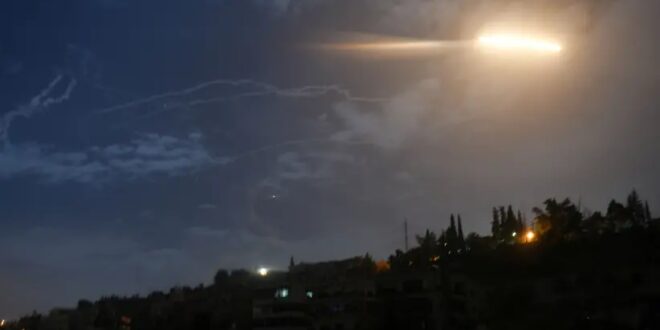The pamphlets were dropped shortly after Israel was accused of striking targets on the Syrian side of the Golan.
The Israeli military dropped leaflets accusing the Syrian Arab Army of cooperating with Hezbollah and explicitly named operatives working for the terrorist group on the Golan Heights, just hours after it carried out airstrikes in the area.
The pamphlets were dropped shortly after Israel was accused by opposition sources of striking targets belonging to Hezbollah’s so-called “Golan File” near al-Ba’ath and al-Krum in the southern Syrian province of Quneitra.
Syria’s SANA news agency later confirmed the strikes, saying: “Zionist occupation forces committed a new aggression in the southern region at dawn today, as part of their repeated aggression against the sanctity and sovereignty of the Syrian territories.”
The source quoted by SANA added, “Syria affirms its right and ability to respond to these attacks and curb the aggressive tendency of the occupation authorities.”
Syrian opposition sources said that among the targets of the attacks were the offices of Bashar Hussein, commander of the Reconnaissance and Observation Company in the 90th Brigade in the Syrian Arab Army.
Hussein was one of the individuals named on the leaflets that warned SAA officers against working with Hezbollah.
התקיפה המיוחסת לישראל בסוריה: גורמים באופוזיציה הסורית דיווחו כי צה"ל פיזר הבוקר עלונים בהם הזהיר מהמשך שיתוף הפעולה של צבא המדינה עם חיזבאללה. כמו כן אמרו כי היעדים שהותקפו הם בניין משרד האוצר, עמדת תצפית בתל כרום ומשרדו של מפקד פלוגת תצפיות, בשאר אל-חוסיין@kaisos1987 pic.twitter.com/dvN5YZGs6e
— כאן חדשות (@kann_news) October 25, 2021The pamphlets also named Jawad Hashem, the son of Munir Shaito (also known as Haj Hashem), who is the commander of the head of the group’s operations on the Golan, and Hussein Hamoush, commander of the 90th Brigade.
Pictures of the men, along with the cars that were driving, were found by local residents on Monday morning. The pamphlets had the eagle symbol of the 210th Bashan Division that defends the area bordering Syria.
“To the Syrian army elements. As we have mentioned in our previous warnings, your continued collaboration with Hezbollah and its stationing in South of Syria is what brings your suffering onto you,” the leaflets said.
“Nevertheless, some of you, such as the head of the reconnaissance unit in the 90th division Colonel Bashar Al Hussein, does not think twice before selling your and the civilians souls for helping Hajj Jawad Hashem, in service of continuing the reconnaissance projects of Hezbollah in the area of Tel Kurom Khan, the Financial building, and other areas, all the while disregarding the general interest and you own safety. Hezbollah is controlling you and using you secretly and publicly. Still, this does not prevent us from revealing its dirty deeds at all times and places.”
Similar pamphlets were dropped in the area by the IDF in May, which warned Hamoush against working with the group.
“Stop cooperating with the Syrian and Lebanese personnel of Hezbollah,” the IDF warned at the time. “Otherwise you will have no peace of mind. We note in particular Brig.-Gen. Hussein Hamoush, commander of Brigade 90. And he is among those who have sold their consciences and their homeland at the cheapest of prices in return for aid for Hezbollah to camouflage their image among their masters, ignoring the general interest and your safety.”
Israel has repeatedly warned that it would not tolerate Tehran’s efforts to establish a permanent military presence in the Syrian Golan, and has admitted to hundreds of strikes against targets belonging to Iran and its proxy, Hezbollah.
The strike comes a few days after Prime Minister Naftali Bennett met in Sochi, Russia, with President Vladimir Putin, who vowed that Moscow wouldn’t hamper Jerusalem’s freedom of action over Syria.
Senior military officials have confirmed that there has been no friction between the two militaries, and that the deconfliction mechanism is working well.
Two weeks ago Israel was accused of killing Madhat al-Salah by sniper fire in the town of Eltinah, near the village of Hadar on the Golan Heights along the border with Israel. Salah had previously spent time in an Israeli prison due to terrorist activities, and was considered a Syrian intelligence activist who was involved in recruiting sources in Israel.
Though Israel has been accused by foreign media of targeting individuals working with Hezbollah in Syria in airstrikes, it was the first time that Israel was accused of using sniper fire against individuals involved with the terror group.
Since Syrian troops recaptured southern Syria and returned to its positions, Hezbollah and Iranian-backed troops have deployed to the area. According to a report by the ALMA Research and Education Center, there are 58 locations belonging to the group in the southern Syrian provinces of Quneitra and Dara’a.
According to the report released last year, there are 28 locations with Hezbollah forces deployed as part of the Southern Command unit, and another 30 locations where there is a presence of cells operating under the Golan Project.
The Southern Command, led by Munir Ali Na’im Shaiti, is the Hezbollah unit in charge of southern Syria whose main function is to create a Hezbollah infrastructure in the area that not only gathers intelligence on the IDF, but trains the Syrian Arab Army 1st Corps for war with Israel.
The Golan Project is under the command of Ali Mussa Daqduq, with headquarters in Damascus and Beirut. Close to 30 cells with dozens of operatives collecting intelligence on Israel and military movements are in the Syrian towns of Hadar, Quinetra and Erneh.
 Eurasia Press & News
Eurasia Press & News



